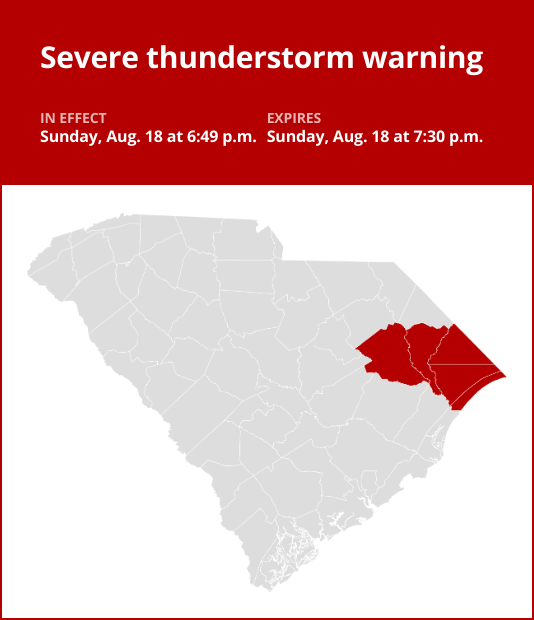On Sunday at 7:17 p.m. the National Weather Service issued an updated severe thunderstorm warning in effect until 7:30 p.m. for Florence, Horry and Marion counties.
Residents should be prepared for wind gusts of up to 60 mph.
“At 7:17 p.m., a severe thunderstorm was located near Pamplico, or 14 miles southwest of Marion, moving east at 25 mph,” states the weather service. “Expect wind damage to trees and power lines.”
Locations impacted by the warning include Pamplico, Gresham, Brittons Neck, Hyman, Kingsburg and Hannah.
The weather service adds, “For your protection move to an interior room on the lowest floor of a building. Please send your reports of hail and/or wind damage, including trees or large limbs downed, by calling the National Weather Service office in Wilmington at 1-800-697-3901.”
This warning is in effect until 7:30 p.m.

Shielding yourself from approaching lightning: Expert safety guidelines
Each year, lightning strikes the United States approximately 25 million times, with the majority of these electrifying events occurring during the summer months. Unfortunately, lightning is responsible for claiming the lives of approximately 20 people annually, as reported by the weather service. The threat of lightning becomes more pronounced as thunderstorms draw nearer, peaking when the storm is directly overhead and gradually waning as it moves away.
To guarantee your safety in the midst of a thunderstorm, take into account the following recommendations:
Lightning safety plan:When venturing outdoors, it’s crucial to have a lightning safety plan in place.
Monitor the sky for threatening signs and listen for the sound of thunder. If thunder is audible, it’s an indication that lightning is nearby.
Seek shelter promptly in a safe location, preferably indoors.
Indoors safety measures:Once you’ve found shelter indoors, abstain from using corded phones, electrical appliances, or plumbing fixtures, and refrain from approaching windows and doors.
Lightning can follow conductive pathways, and these precautions reduce the risk of electrical surges.
Wait for the all-clear:After the last lightning strike or thunderclap, wait at least 30 minutes before resuming outdoor activities.
It’s important to remember that lightning can strike even when a storm seems to have passed, so exercise caution.
When indoor shelter isn’t available:If you find yourself outdoors with no access to indoor shelter during a thunderstorm, take these steps to maximize your safety:
Avoid open fields, hilltops, or ridge crests, as they expose you to greater lightning risk.
Steer clear of tall, isolated trees and other prominent objects. In forested areas, stay close to lower stands of trees.
If you’re with a group, ensure individuals are spread out to prevent lightning current from transferring between people.
Camping in an open setting during a thunderstorm is strongly discouraged. If no alternative exists, set up camp in a valley, ravine, or other low-lying areas. Remember that a tent offers no protection against lightning.
Do not approach water bodies, wet objects, or metal items. While water and metal don’t attract lightning, they conduct electricity effectively and can pose significant risks.
In summary, when facing the threat of lightning, vigilance and preparedness are your best allies. By following these guidelines, you can significantly reduce the chances of lightning-related accidents and prioritize your safety.
Driving through downpours: Safety guidelines for wet roads
Rain can turn roads into hazards. Stay informed and follow these tips from the weather service to ensure safety during heavy rainfall:
Beware of swollen waterways:In heavy rain, refrain from parking or walking near culverts or drainage ditches, where swift-moving water can pose a grave danger.
Maintain safe driving distances:Adhere to the two-second rule for maintaining a safe following distance behind the vehicle in front of you. In heavy rain, allow an additional two seconds of distance to compensate for reduced traction and braking effectiveness.
Reduce speed and drive cautiously:If it is raining and the roads are wet, slow down. Take your foot off the accelerator and let your speed drop gradually. Never use the brakes suddenly because this may cause the car to skid.
Choose your lane wisely:Stick to the middle lanes on multi-lane roads to minimize the risk of hydroplaning, as water tends to accumulate in outer lanes.
Visibility matters:Turn on your headlights and be careful of other vehicles to the rear and in blind spot areas as they are especially difficult to see through rain-spattered windows.
Watch out for slippery roads:The first half-hour of rain is when roads are slickest due to a mix of rain, grime, and oil. Exercise heightened caution during this period.
Keep a safe distance from large vehicles:Large trucks and buses can reduce your visibility with tire spray. Avoid tailgating and pass them swiftly and safely.
Mind your windshield wipers:Overloaded wiper blades can hinder visibility. If rain severely impairs your vision, pull over and wait for conditions to improve. Seek refuge at rest areas or sheltered spots.
When stopping by the roadside is your only option, position your vehicle as far off the road as possible, ideally beyond guardrails. Keep your headlights on and activate emergency flashers to alert other drivers of your position.
In the face of heavy rain, these precautions can make a significant difference in ensuring your safety on the road. Remember to stay informed about weather conditions and heed guidance from local authorities for a secure journey.






